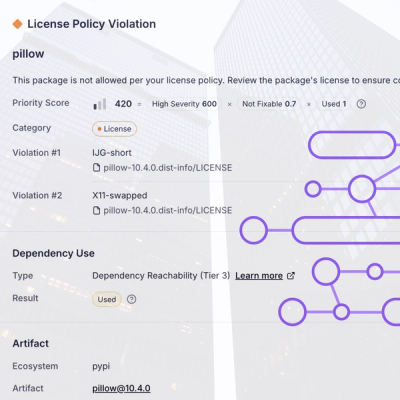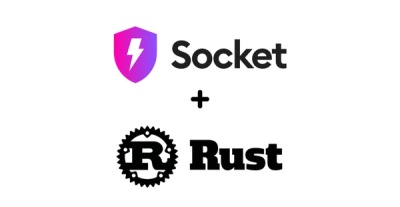
Research
/Security News
Critical Vulnerability in NestJS Devtools: Localhost RCE via Sandbox Escape
A flawed sandbox in @nestjs/devtools-integration lets attackers run code on your machine via CSRF, leading to full Remote Code Execution (RCE).
react-tv-player
Advanced tools
A React media player component for TV devices. With custom UI and arrow-key navigation, it can play a variety of URLs like file paths, HLS/DASH streams and even YouTube & Vimeo links directly. Packaged as an npm library for easy integration.
A React media player component for TV devices. With custom UI and arrow-key navigation, it can play a variety of URLs like file paths, HLS/DASH streams and even YouTube links directly. Packaged as an npm library.
Click on the image to try out the demo on a desktop browser
npm install react-tv-player
Just import the player and render it in your app or page with props:
import { TVPlayer } from "react-tv-player";
function App() {
return (
<>
<TVPlayer url="https://www.youtube.com/watch?v=SkVqJ1SGeL0" />
</>
);
}
The demo source code App.tsx illustrates how the component can be initialised with more props such as metadata, custom buttons, preview images and multiple media, enabling the user to cycle through videos with next/previous buttons:
<TVPlayer
title={mediaList[mediaIndex].title}
subTitle={mediaList[mediaIndex].subTitle}
url={mediaList[mediaIndex].url}
light={mediaList[mediaIndex].preview}
customButtons={customButtons}
mediaCount={mediaList.length}
onLikePress={handleLike}
/>
Here is a short video of the demo runnning on a browser:
https://github.com/lewhunt/react-tv-player/assets/9886284/7baa4b75-491b-49f3-8cf1-698ae7f55941
I've dedicated years working with various OTT players on big-screen devices. During this journey, two persistent challenges surfaced time and again: performant UI and compatible media encodings. These hurdles often forced us to heavily customise libraries and tackle streaming difficulties, leading to added costs and frustrating delays. 😫
Enter ReactTVPlayer, an open-source media player component for TV devices that lowers the barrier to entry and seamlessly integrates with your React applications. :muscle:
It's designed for TV experiences out of the box, complete with customisable UI buttons and intuitive cursor plus arrow key navigation. 🎮 In addition to handling HLS and Dash streams effortlessly, it tackles the formidable challenge of playing YouTube and Vimeo urls directly on TV, saving you the hassle and cost of additional video encoding. 🎉
Under the hood, this component harnesses the power of open-source libraries like Norigin Media's spatial navigation hook. It builds upon the excellence of React Player, which utilises hls.js and dash.js. Powered by React TypeScript (although you don't need to use TypeScript to make the most of it), this library is packaged efficiently using Vite, making integration a breeze. 🙌
The full list of props are below. Media related values such as playing, loop and muted are also mapped to state which can be accessed via the useTVPlayerStore hook instead of updating props.
| Prop | Description | Default |
|---|---|---|
url | The url of the media to play ◦ This can be an embedded url from YouTube/SoundCloud, a file path or a HLS or Dash manifest stream | |
playing | Set to true or false to pause or play the media. ◦ Set to true to autoplay the media (muted may also be needed in some browsers) | false |
loop | Set to true to loop the media | false |
controls | Set to true to display native HTML5 media controls instead of custom TV Player UI controls | false |
light | Set to true or a url string to show a preview image, which then loads the full player on selecting play◦ Pass in true to use the default preview image associated with an embeded media url (e.g. YouTube/SoundCloud urls) ◦ Pass in an image URL to override any default preview image | false |
volume | Set the volume of the player, between 0 and 1 | null |
muted | Set to true to mute the player◦ may be required if you intend to autoplay media | false |
playbackRate | Set the playback rate of the player ◦ Only supported by YouTube, Wistia, and file paths | 1 |
disableFullscreen | Set to true to disable the defaulted fullscreen width and height of the player. ◦ Width and height values below should be defined ◦ See App.tsx useEffect for example of toggling body properties based on fullscreen state | false |
disableInitNav | Set to true to disable initialisation of the norigin spatial navigation library. ◦ Set this if you are already initialising the navigation library in your own app | false |
disableNav | Set to true to pause arrow key navigation of the norigin spatial navigation library in the player. ◦ Set this if you show a custom menu and want to disable the player's key event handlers. | false |
width | Set the width of the player when fullscreen is disabled | 100% |
height | Set the height of the player when fullscreen is disabled | 350px |
style | Add inline styles to the root element | {} |
customButtons | Specify a collection of custom buttons for the player UI ◦ A set of default buttons will be used otherwise. | null |
title | Set a string title for the current media.◦ Embedded media urls such as YouTube will attempt to pull in the default media title if not overridden here. | |
subTitle | Set a string sub-title for the current media.◦ Embedded media urls such as YouTube will attempt to pull in the default author name if not overridden here. | |
mediaCount | Set the total number of media items if you have multiple media and want player to display next and previous buttons | 0 |
mediaIndex | Set the initial media index number if you have multiple media and want player to handle next and previous buttons | 0 |
hideControlsOnArrowUp | Set to true to hide the player UI by using the up arrow key when focussed on the player buttons | false |
Callback props take a function that gets fired on various player events and UI button actions:
| Prop | Description |
|---|---|
onReady | Called when media is loaded and ready to play. If playing is set to true, media will play immediately |
onStart | Called when media starts playing |
onPlay | Called when media starts or resumes playing after pausing or buffering |
onPause | Called when media is paused |
onBuffer | Called when media starts buffering |
onEnded | Called when media finishes playing ◦ Does not fire when loop is set to true |
onError | Called when an error occurs whilst attempting to play media |
onSkipBackPress | Called when the Skip Back button is pressed |
onSkipForwardPress | Called when the Skip Forward button is pressed |
onPreviousPress | Called when the Previous button is pressed |
onNextPress | Called when the Next button is pressed |
onLikePress | Called when the Like button is pressed |
onLoopPress | Called when the Loop button is pressed |
onMutePress | Called when the Mute button is pressed |
onFullscreenPress | Called when the Fullscreen button is pressed |
As illustrated in the sample demo app, the player can be overridden with custom buttons. There is a selection of pre-built action types with their own icons and behaviours or you can add your own with the "custom" action type.
import { TVPlayer, TVPlayerButtonProps } from "react-tv-player";
import { faGithub } from "@fortawesome/free-brands-svg-icons";
const customButtons: TVPlayerButtonProps[] = [
{ action: "loop", align: "left" },
{ action: "like", align: "left" },
{ action: "previous", align: "center" },
{ action: "playpause", align: "center" },
{ action: "next", align: "center" },
{ action: "mute", align: "right" },
{
action: "custom",
align: "right",
label: "About",
faIcon: faGithub,
onPress: () => {
window.location.href = "https://github.com/lewhunt/react-tv-player";
},
},
];
<TVPlayer
url="https://www.youtube.com/watch?v=SkVqJ1SGeL0"
customButtons={customButtons}
/>;
| Button Props | Description |
|---|---|
action | Choose from custom or one of the pre-built actions: like, loop, mute,next,playpause,previous,skipforward, skipback, fullscreen |
align | Alignment of the button. Choose from left,center, right |
label | A hint text label to appear below the current button in focus. Pre-built button actions use relevent labels. |
faIcon | A font-awesome icon. Pre-built button actions use relevent icons. |
onPress | Called when a button is pressed. Pre-built button actions have their own behaviours. |
onRelease | Called when a button is released. Currently unused. |
isSelectedFill | Allows support of toggle behaviour (in the form of a button fill) when set to true. |
disable | Prevents button action when set to true. |
For more control you can import the useTVPlayerStore custom hook to globally access player state (zustand store). View the sample app and the TVPlayerUI inner component for examples of use. Below shows the basics:
// 1. import useTVPlayerStore
import { TVPlayer, useTVPlayerStore } from "react-tv-player";
// 2. get state values (there are more availble, see TVPlayerUI.ts for reference)
const actions = useTVPlayerStore((s) => s.actions);
const playing = useTVPlayerStore((s) => s.playing);
const player = useTVPlayerStore((s) => s.player);
const likeToggle = useTVPlayerStore((s) => s.likeToggle);
s;
const logPlaybackState = () => console.log(playing);
//3. set state using the actions object
const handleLike = () => {
console.log("like button pressed");
actions.setLikeToggle(!likeToggle);
};
const togglePlayback = () => {
actions.setPlaying(!playing);
};
//4. access player instance methods via the player state
const customSeek = () => player.seekTo(player.getCurrentTime() + 10);
<TVPlayer
url="https://www.youtube.com/watch?v=SkVqJ1SGeL0"
onLikePress={handleLike}
/>;
Use the state's player reference - as in the above example - to call instance methods on the player.
| Method | Description |
|---|---|
seekTo(amount, type) | Seek to the given number of seconds, or fraction if amount is between 0 and 1◦ type parameter lets you specify 'seconds' or 'fraction' to override default behaviour |
getCurrentTime() | Returns the number of seconds that have been played ◦ Returns null if unavailable |
getSecondsLoaded() | Returns the number of seconds that have been loaded ◦ Returns null if unavailable or unsupported |
getDuration() | Returns the duration (in seconds) of the currently playing media ◦ Returns null if duration is unavailable |
getInternalPlayer() | Returns the internal player of whatever is currently playing ◦ eg the YouTube player instance, or the <video> element when playing a video file◦ Use getInternalPlayer('hls') to get the hls.js player◦ Use getInternalPlayer('dash') to get the dash.js player◦ Returns null if the internal player is unavailable |
I hope this has given a good intro to the component.
💬 Fire over a comment if you have any feedback, requests or issues 🐛
⭐ Give it a star if you like the component or want to bookmark it 🙏
FAQs
A React media player component for TV devices. With custom UI and arrow-key navigation, it can play a variety of URLs like file paths, HLS/DASH streams and even YouTube & Vimeo links directly. Packaged as an npm library for easy integration.
The npm package react-tv-player receives a total of 82 weekly downloads. As such, react-tv-player popularity was classified as not popular.
We found that react-tv-player demonstrated a healthy version release cadence and project activity because the last version was released less than a year ago. It has 1 open source maintainer collaborating on the project.
Did you know?

Socket for GitHub automatically highlights issues in each pull request and monitors the health of all your open source dependencies. Discover the contents of your packages and block harmful activity before you install or update your dependencies.

Research
/Security News
A flawed sandbox in @nestjs/devtools-integration lets attackers run code on your machine via CSRF, leading to full Remote Code Execution (RCE).

Product
Customize license detection with Socket’s new license overlays: gain control, reduce noise, and handle edge cases with precision.

Product
Socket now supports Rust and Cargo, offering package search for all users and experimental SBOM generation for enterprise projects.